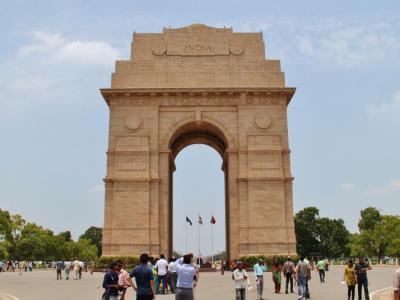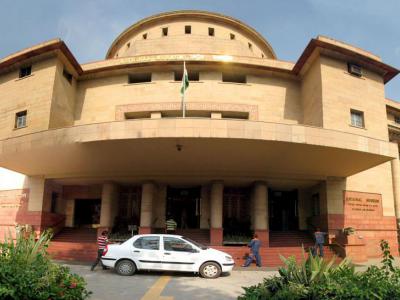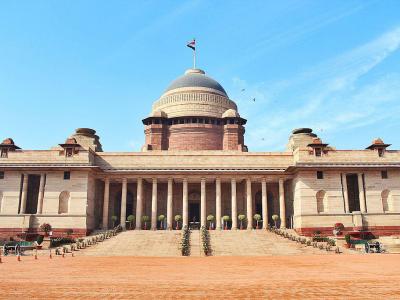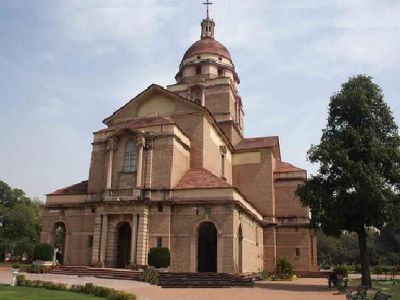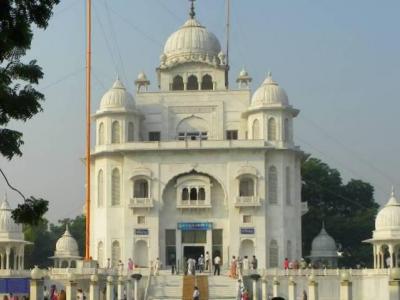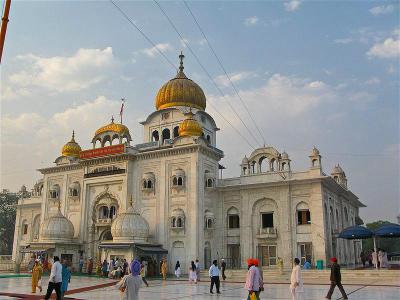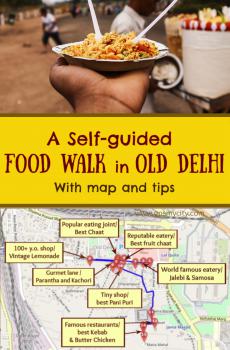
New Delhi Introduction Walking Tour (Self Guided), Delhi
Delhi is the second largest city in India and one of the world's oldest metropolitan areas, continuously inhabited since the 6th century BC. Due to its location, for years this place has been coveted by numerous empires and dynasties, starting from the ancient ruler of the Kuru Empire to the British Raj, who have fought for and seized control of it.
Although Delhi has more than two millennia of history under its belt, the capital of India, also known as New Delhi, is relatively new. The foundation stone of New Delhi was laid by British King George V during the Delhi Durbar of 1911. The new capital was designed by British architects Sir Edwin Lutyens and Sir Herbert Baker, and was inaugurated on 13 February 1931.
Much of what makes Delhi such a fascinating tourist destination is the rich and diverse culture. Traditionally, a trip to New Delhi starts at the India Gate, symbol of the city. Another must-do is a walk along Rajpath - the wide ceremonial boulevard at the heart of the city, replete with prime examples of British colonial architecture.
Visitors can also admire the beautiful Sikh house of worship, Gurudwara Bangla Sahib, built during the reign of the Mughal Emperors, and learn a great deal of the country's history and art whilst exploring the National Museum of Delhi. To add a delicious touch to your cultural experience, you may want to grab a bite at a local restaurant or street market found in abundance throughout the city.
If you're ready to learn more about New Delhi and see some of its most significant and vibrant sights, take this self-guided walking tour!
Although Delhi has more than two millennia of history under its belt, the capital of India, also known as New Delhi, is relatively new. The foundation stone of New Delhi was laid by British King George V during the Delhi Durbar of 1911. The new capital was designed by British architects Sir Edwin Lutyens and Sir Herbert Baker, and was inaugurated on 13 February 1931.
Much of what makes Delhi such a fascinating tourist destination is the rich and diverse culture. Traditionally, a trip to New Delhi starts at the India Gate, symbol of the city. Another must-do is a walk along Rajpath - the wide ceremonial boulevard at the heart of the city, replete with prime examples of British colonial architecture.
Visitors can also admire the beautiful Sikh house of worship, Gurudwara Bangla Sahib, built during the reign of the Mughal Emperors, and learn a great deal of the country's history and art whilst exploring the National Museum of Delhi. To add a delicious touch to your cultural experience, you may want to grab a bite at a local restaurant or street market found in abundance throughout the city.
If you're ready to learn more about New Delhi and see some of its most significant and vibrant sights, take this self-guided walking tour!
How it works: Download the app "GPSmyCity: Walks in 1K+ Cities" from Apple App Store or Google Play Store to your mobile phone or tablet. The app turns your mobile device into a personal tour guide and its built-in GPS navigation functions guide you from one tour stop to next. The app works offline, so no data plan is needed when traveling abroad.
New Delhi Introduction Walking Tour Map
Guide Name: New Delhi Introduction Walking Tour
Guide Location: India » Delhi (See other walking tours in Delhi)
Guide Type: Self-guided Walking Tour (Sightseeing)
# of Attractions: 7
Tour Duration: 2 Hour(s)
Travel Distance: 5.2 Km or 3.2 Miles
Author: doris
Sight(s) Featured in This Guide:
Guide Location: India » Delhi (See other walking tours in Delhi)
Guide Type: Self-guided Walking Tour (Sightseeing)
# of Attractions: 7
Tour Duration: 2 Hour(s)
Travel Distance: 5.2 Km or 3.2 Miles
Author: doris
Sight(s) Featured in This Guide:
- India Gate & Rajpath
- National Museum of Delhi
- Rashtrapati Bhawan
- Cathedral Church of the Redemption
- Gurdwara Rakab Ganj Sahib
- Parliament House
- Gurudwara Bangla Sahib
1) India Gate & Rajpath (must see)
Rajpath is a road in Delhi that runs between the Rashtrapati Bhavan and Delhi's National Stadium. It is considered to be one of the most important boulevards in India.
Rajpath was conceived in 1911 by Sir Edwin Lutyens. He envisioned the road to be the center of all of British India. Many of the buildings that flank the road are government buildings that were also designed by Lutyens. Landmarks include the Secretariat Building, Vijay Chowk, the National War Memorial and India Gate.
The street also takes tourists near the Indira Gandhi Centre for the Arts and Exhibition Hall, the National Museum and Parliament House.
India Gate is a symbolic memorial east of Rajpath. The gate stands in recognition of the more than 70,000 soldiers who died during World War I and the third Anglo-Afghan War.
Like many of the buildings and memorials near Rajpath, India Gate was designed by Sir Edwin Lutyens. He modeled the gate after the Arc de Triomphe in Paris and the Arch of Constantine in Rome. India Gate was established in 1921 and completed 10 years later.
East of India Gate is the Canopy. This 73-foot cupola once held a statue of George V. It was removed in 1968 and eventually placed in Coronation Park.
Visitors will also see Amar Jawan Jyoti, or the Flame of the Immortal Soldier. The black marble plinth is located inside the gate as a dedication to unknown soldiers. Amar Jawan Jyoti was added to the structure in 1972 at the request of Prime Minister Indira Gandhi.
Rajpath was conceived in 1911 by Sir Edwin Lutyens. He envisioned the road to be the center of all of British India. Many of the buildings that flank the road are government buildings that were also designed by Lutyens. Landmarks include the Secretariat Building, Vijay Chowk, the National War Memorial and India Gate.
The street also takes tourists near the Indira Gandhi Centre for the Arts and Exhibition Hall, the National Museum and Parliament House.
India Gate is a symbolic memorial east of Rajpath. The gate stands in recognition of the more than 70,000 soldiers who died during World War I and the third Anglo-Afghan War.
Like many of the buildings and memorials near Rajpath, India Gate was designed by Sir Edwin Lutyens. He modeled the gate after the Arc de Triomphe in Paris and the Arch of Constantine in Rome. India Gate was established in 1921 and completed 10 years later.
East of India Gate is the Canopy. This 73-foot cupola once held a statue of George V. It was removed in 1968 and eventually placed in Coronation Park.
Visitors will also see Amar Jawan Jyoti, or the Flame of the Immortal Soldier. The black marble plinth is located inside the gate as a dedication to unknown soldiers. Amar Jawan Jyoti was added to the structure in 1972 at the request of Prime Minister Indira Gandhi.
2) National Museum of Delhi
The National Museum is the second largest museum in Delhi. Brainchild of Pandit Jawaharlal Nehru, the museum was inaugurated by Sri R.C. Rajagopalachari, the first Governor General of Independent India in 1949. Here you will find thousands of exquisite artworks that depict Indian cultural heritage. These art pieces were collected from all over India and across the globe.
The museum contains a great collection of rare coins, costumes, jewelry, terracotta sculptures, statues made of bronze and copper, manuscripts and weapons. You will also find a range of artifacts dating back to the Mauryan Empire, Chola dynasty, Bahmani and Vijaynagar kingdoms. The weapons, costumes and murals of tribal communities can also be found here.
The National Museum comprises of a gallery dedicated to the Indus valley Civilization. Here you can find numerous items excavated from Harappa and Mohenjo-Daro such as seals and tablets. You will gain an in-depth knowledge on the unique town planning methods adopted in these cities. The sculpture of a dancing girl found in the ruins of Mohenjo-Daro is the highlight of this museum.
Do not miss the original copy of Gita Govindha and Baghwath Gita in golden alphabet displayed here. At this museum, you can also find musical instruments invented by the famous poet and musician Amir Khusru.
The museum contains a great collection of rare coins, costumes, jewelry, terracotta sculptures, statues made of bronze and copper, manuscripts and weapons. You will also find a range of artifacts dating back to the Mauryan Empire, Chola dynasty, Bahmani and Vijaynagar kingdoms. The weapons, costumes and murals of tribal communities can also be found here.
The National Museum comprises of a gallery dedicated to the Indus valley Civilization. Here you can find numerous items excavated from Harappa and Mohenjo-Daro such as seals and tablets. You will gain an in-depth knowledge on the unique town planning methods adopted in these cities. The sculpture of a dancing girl found in the ruins of Mohenjo-Daro is the highlight of this museum.
Do not miss the original copy of Gita Govindha and Baghwath Gita in golden alphabet displayed here. At this museum, you can also find musical instruments invented by the famous poet and musician Amir Khusru.
3) Rashtrapati Bhawan (must see)
Situated at Raisina Hills in New Delhi, the Bhawan is the authorized abode of the president of India. It is also one of the major tourist attractions in New Delhi. Rashtrapati Bhawan once served as the dwelling place of Governor General of India during the British rule. Sir Edwin Lutyens designed this building which was completed in 1929 and inaugurated in 1931. You will find an interesting mix of Indian, Mughal and European colonial architectural features.
Spread over 20,000 square feet, Rashtrapati Bhawan has 340 luxurious rooms that include the State Drawing room, State Library, State Ball room and so on. The Darbar room is used for prize awarding ceremonies. There is a beautiful Mughal garden to the west of the Bhawan where varieties of roses are grown. This garden is open to public between February and March every year. You must take permission officially to visit this Bhawan.
A chandelier weighing two tons adorns the main hall. This chandelier adds to the grandeur and elegance of the interiors. The hall is used for official ceremonies. Interior of the Rashtrapati Bhawan is simple and elegant. Heavy stone works and shapes used in the building lend an ornamental appearance. Do not miss out the eight lions spilling water into the basins near the Viceroy’s stairs at the Bhavan.
Spread over 20,000 square feet, Rashtrapati Bhawan has 340 luxurious rooms that include the State Drawing room, State Library, State Ball room and so on. The Darbar room is used for prize awarding ceremonies. There is a beautiful Mughal garden to the west of the Bhawan where varieties of roses are grown. This garden is open to public between February and March every year. You must take permission officially to visit this Bhawan.
A chandelier weighing two tons adorns the main hall. This chandelier adds to the grandeur and elegance of the interiors. The hall is used for official ceremonies. Interior of the Rashtrapati Bhawan is simple and elegant. Heavy stone works and shapes used in the building lend an ornamental appearance. Do not miss out the eight lions spilling water into the basins near the Viceroy’s stairs at the Bhavan.
4) Cathedral Church of the Redemption
The Cathedral Church of the Redemption is located near the Parliament House in New Delhi. It was built in the early 1900s to meet the spiritual needs of English people. Henry Medd, a British architect designed this church in such a manner that it remains cool even during the hot summer months. Lord Irwin, the then Viceroy donated a silver cross to the Church, after he narrowly escaped an accident in 1929. He also gave a picture of Mary and infant Jesus to express his gratitude to God.
The exterior of the Cathedral Church looks normal. It has a simple roof made of red sandstone. However, the splendid interior of the church will take you by surprise. The eye-catching glass windows are very large and stained to filter sunlight. The delicate domes and gorgeously carved arches beautify the church and give it a magnificent ambiance. Mass prayers are held every morning and evening. You can feel the spiritual aura in this church.
Cathedral Church of redemption hosts innumerable concerts and festivals. Besides religious festivals, the church is also a hub for cultural programs. It has a choir by name the Capital City Minstrels. You can enjoy listening to the soothing choral music on religious occasions.
The exterior of the Cathedral Church looks normal. It has a simple roof made of red sandstone. However, the splendid interior of the church will take you by surprise. The eye-catching glass windows are very large and stained to filter sunlight. The delicate domes and gorgeously carved arches beautify the church and give it a magnificent ambiance. Mass prayers are held every morning and evening. You can feel the spiritual aura in this church.
Cathedral Church of redemption hosts innumerable concerts and festivals. Besides religious festivals, the church is also a hub for cultural programs. It has a choir by name the Capital City Minstrels. You can enjoy listening to the soothing choral music on religious occasions.
5) Gurdwara Rakab Ganj Sahib
Gurdwara Rakab Ganj Sahib is a sacred site with historical significance. This gurdwara is a shrine and place of worship that was built on the cremation site of the ninth Sikh Guru, Guru Tegh Bahadur. It is now a Sikh pilgrimage destination.
The history of the building dates to 1675 when Tegh Bahadur was publicly beheaded by order of the Mughal Emperor Aurangzeb after refusing to convert to Islam. A disciple of Tegh Bahadur, Lakhi Shah Banjara, burned his house in order to cremate the body. It was on this spot that Gurdwara Rakab Ganj Sahib was built.
Gurdwara Rakab Ganj Sahib is built from white marble using Sikh architecture. A prime example of Sikh architecture is the presence of four entrances. This signifies that people from all religions, genders and races are welcome.
The gurdwara is open from 5 AM through 10 PM. Those who do not Sikhism should remember to remove their shoes and socks while also keeping their head covered before entering the gurdwara.
The history of the building dates to 1675 when Tegh Bahadur was publicly beheaded by order of the Mughal Emperor Aurangzeb after refusing to convert to Islam. A disciple of Tegh Bahadur, Lakhi Shah Banjara, burned his house in order to cremate the body. It was on this spot that Gurdwara Rakab Ganj Sahib was built.
Gurdwara Rakab Ganj Sahib is built from white marble using Sikh architecture. A prime example of Sikh architecture is the presence of four entrances. This signifies that people from all religions, genders and races are welcome.
The gurdwara is open from 5 AM through 10 PM. Those who do not Sikhism should remember to remove their shoes and socks while also keeping their head covered before entering the gurdwara.
6) Parliament House
Parliament House is the center of government in India. It is home to Lok Sobha (House of the People) and Rajya Sabha (Council of States). It is located near the office and residence of the prime minister as well as a number of other administrative and ministerial buildings.
Construction on Parliament House began in 1921 and was completed in 1927. It was designed by Sir Edwin Lutyens and Sir Herbert Baker. The architectural style of the building is the unique Lutyens' Delhi, which combines Neo-Classical architecture with Mughal and Buddhist influences.
The building is circular and surrounded by 144 columns. Visitors can get an excellent view of this architecture and the gardens when they visit the Parliament Museum that is held within the library building. It is open from 11 AM through 5 PM Tuesday through Saturday.
A new parliament building is under construction. Once that building is completed, Parliament House will be turned into a permanent museum.
Construction on Parliament House began in 1921 and was completed in 1927. It was designed by Sir Edwin Lutyens and Sir Herbert Baker. The architectural style of the building is the unique Lutyens' Delhi, which combines Neo-Classical architecture with Mughal and Buddhist influences.
The building is circular and surrounded by 144 columns. Visitors can get an excellent view of this architecture and the gardens when they visit the Parliament Museum that is held within the library building. It is open from 11 AM through 5 PM Tuesday through Saturday.
A new parliament building is under construction. Once that building is completed, Parliament House will be turned into a permanent museum.
7) Gurudwara Bangla Sahib (must see)
Constructed in 1783, this is one of the most prominent Sikh gurdwara (or Sikh house of worship), known for its association with the eighth Sikh Guru, Guru Har Krishan, as well as the pool inside its complex, known as the "Sarovar". Instantly recognisable by its golden dome and tall flagpole, it is a landmark of the city of Delhi.
The grounds include the Gurudwara, a kitchen, a large (holy) pond, a school, and an art gallery. As with all Sikh Gurdwaras, the concept of langar is practiced, and all people regardless of race or religion may eat in the Gurdwara kitchen (langar hall). The Langar (food) is prepared by gursikhs who work there and also by volunteers who like to help out. At the Gurdwara, visitors are requested to cover their hair and not to wear shoes. Assistance to foreigners and visitors with Guides, head scarves, and shoe-minding service can be found inside the compound and are available free of charge.
Why You Should Visit:
It's amazing how such a place of peace and overwhelming spirituality can exist in such a chaotic city!
A perfect setting for clearing your head, praying, walking, and just enjoying the beauty of it all.
Tip:
Make your way to the Visitor Center first. You will leave your shoes and socks there (totally safe), and they will lend you something to cover your head.
Remember to take a tour of the kitchens where thousands of meals are prepared for the communal meal on a daily basis – you could even give a hand!
Outside the temple, around the "pool", there are plenty of stalls to purchase Sikh objects and souvenirs.
The grounds include the Gurudwara, a kitchen, a large (holy) pond, a school, and an art gallery. As with all Sikh Gurdwaras, the concept of langar is practiced, and all people regardless of race or religion may eat in the Gurdwara kitchen (langar hall). The Langar (food) is prepared by gursikhs who work there and also by volunteers who like to help out. At the Gurdwara, visitors are requested to cover their hair and not to wear shoes. Assistance to foreigners and visitors with Guides, head scarves, and shoe-minding service can be found inside the compound and are available free of charge.
Why You Should Visit:
It's amazing how such a place of peace and overwhelming spirituality can exist in such a chaotic city!
A perfect setting for clearing your head, praying, walking, and just enjoying the beauty of it all.
Tip:
Make your way to the Visitor Center first. You will leave your shoes and socks there (totally safe), and they will lend you something to cover your head.
Remember to take a tour of the kitchens where thousands of meals are prepared for the communal meal on a daily basis – you could even give a hand!
Outside the temple, around the "pool", there are plenty of stalls to purchase Sikh objects and souvenirs.
Walking Tours in Delhi, India
Create Your Own Walk in Delhi
Creating your own self-guided walk in Delhi is easy and fun. Choose the city attractions that you want to see and a walk route map will be created just for you. You can even set your hotel as the start point of the walk.
Old Delhi Walking Tour
Old Delhi, as a walled city, was founded in 1639 under the Mughal emperor Shah Jahan, who decided to move his domain's capital here from Agra. The construction of the city was completed in 1648, from which point on Delhi had remained the capital of the Mughal Empire until its fall in 1857.
Once filled with mansions and havelis (traditional townhouses) of the nobles and members of the royal... view more
Tour Duration: 2 Hour(s)
Travel Distance: 3.3 Km or 2.1 Miles
Once filled with mansions and havelis (traditional townhouses) of the nobles and members of the royal... view more
Tour Duration: 2 Hour(s)
Travel Distance: 3.3 Km or 2.1 Miles
Useful Travel Guides for Planning Your Trip
A Self-Guided Food Walk in Old Delhi
India, the Land of Spices, is a long standing superpower in terms of food whose cooking, once exotic, in recent decades has splashed out far and wide across continents. Amid the country's myriads of regional cuisines, Old Delhi has its own loud say on the matter – something one can easily...
Delhi Shopping Tips: 16 Indian Goods To Bring Home
Singling out a thing or two for a gift from India, in general, and Delhi, in particular, is a tough job indeed, for this part of the world is rightly reputed to be the treasure trove of all things exciting. Spices, exotic food, jewellery, objects of art, oriental fashion... The list can be long....
The Most Popular Cities
/ view all
